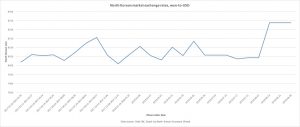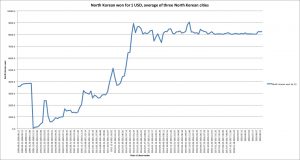Citizens of poorer countries typically focus their energy on subsistence agriculture in order to survive. In North Korea, this focus has widely occurred at the expense of environmental issues, with many in the country viewing environmentalism as a “luxury.”
However, there will likely be an increase in environmental awareness when the economy improves through reforms and opening. Increases in personal income levels will allow the population to pay more attention to and seek ways to address environmental issues.
North Korea has experienced severe environmental destruction over the past 70 years. Widespread logging has left barren vistas throughout the country, exemplifying the poor state of North Korea’s natural environment and serving as a stark reminder of the economic, technological and societal factors at play.
The Korea Forest Research Institute (KFRI) in South Korea has published satellite images showing the extent of North Korea’s environmental destruction. According to the data, forests once covered 9,160,000 hectares of North Korean territory, with 2,840,000 hectares of this forest area now destroyed. This means that 32% of North Korea’s total forest area has been wiped out, an area 46 times the size of the city of Seoul.
The regime has paid very little attention to environmental conservation and as a result the country frequently suffers massive loss of human life due to landslides and other natural disasters.
Recently, however, there are signs that the North Korean government is paying more attention to the fate of its forests. In early July, Kim Jong Un, during an on-site visit to a reed branch farm in North Pyongan Province and the Sinuiju Chemical Textile Factory, which produces paper and textiles with reeds, located around Sinuiju, commented on the insufficient supply of paper and called for support for paper companies making paper out of reeds (as opposed to wood).
North Korea’s paper industry is almost completely dependent on using pulp, which is made out of wood. Pulp is made by mixing water with wood sourced from coniferous trees. Pulp contains lignin and other elements which makes it relatively practical during the manufacturing process, but because it can easily change color it cannot be used for high-quality paper. Instead, it is commonly used for newspapers.
The Rodong Sinmun and other state propaganda materials are almost all made out of paper produced from pulp.
North Korea created the 121 Cooperative Enterprise under the management of the Korean Workers’ Party’s Financial Administration Department to produce paper for the Rodong Sinmun. This enterprise operates a network of tree harvesting companies based throughout the country that fell thousands of trees each year.
The trees are then transported from forests near the Amnok River, Chongchun River and Duman River to Kilju, Sinuiju and Anju where they are made into pulp and finally turned into paper for newspapers at the 121 Paper Factory in Anju, South Pyongan Province. Most of the wood harvested each year in North Korea is used for newspapers or other government projects and amounts to significant volumes.
The destruction of the country’s forests has increased annually and most of it is due to the activities of the North Korean government.
North Korea has recently paid more attention to the preservation of its natural environment, and a welcome sign is that the country is making more paper out of reeds than wood. However, the country lacks the technical ability to assess its own environmental issues and has not put in place the proper systems to take advantage of production methods that are cleaner and more efficient.
North Korea has long had notional policies to protect its environment. The country’s environmental protection agency was made independent from the Ministry of Security in the late 1980s and became the “Ministry of Land and Environment Protection.” In April 1998, as the rest of the government shrank in size due to the economic crisis, this ministry was expanded and turned into a full government ministry. The ministry was instrumental in helping environmental protection and management practices become more systematic through the establishment of forestry administration offices, nurseries, and forest monitoring centers under each of the country’s provincial governments.
These organizations designated a period of mass mobilization each spring and fall for citizens to plant trees and conduct activities related to the prevention of landslides and mudslides. Ironically, however, North Korea’s forests have been degraded even further despite these efforts. This is largely due to the fact that the government still relies heavily on wood products.
North Korea’s policy of self-sufficiency in the economic sphere has continued to raise the country’s dependence on wood and led to accelerating deforestation throughout the country, which in turn leads to greater destruction arising from natural disasters.
Mountainous areas and those near rivers suffer the most from deforestation. Areas without trees can experience massive mudslides, even after only receiving light rainfall.
Daily NK sources recently reported that significant loss of human life and destruction of property occurred during a landslide following rainfall near a dam construction site in North Pyongan Province. The sources said that deforestation that had occurred near the construction site was to blame.
The construction of power plants and roads typically leads to the complete deforestation of mountains nearby. The state is unable to provide the wood required for construction, and so construction workers must find a way to handle the lack of materials themselves. They have little choice but to cut down trees near the construction site.
North Korea is now focusing on the construction of massive dams as a way to increase its energy supply. This construction is leading to the deforestation of nearby forest areas.
Deforestation enacts a heavy toll on North Korea’s economy and its population is becoming more concerned about its effects. Many complain that the deforestation is damaging their own ability to lead happy lives.
North Korea is faced with a whole slew of issues: lack of energy for its citizens; the lack of economic power to deal with its environmental problems; and a planned economy that has only hampered economic development. The country must, however, implement more environmentally-friendly economic policies before further damage occurs.
The North Korean government must address the social, technological, economic and market-related factors that drive deforestation. They must also be open to assistance from abroad so that their attempts to prevent further deforestation and protect existing forests are successful.


